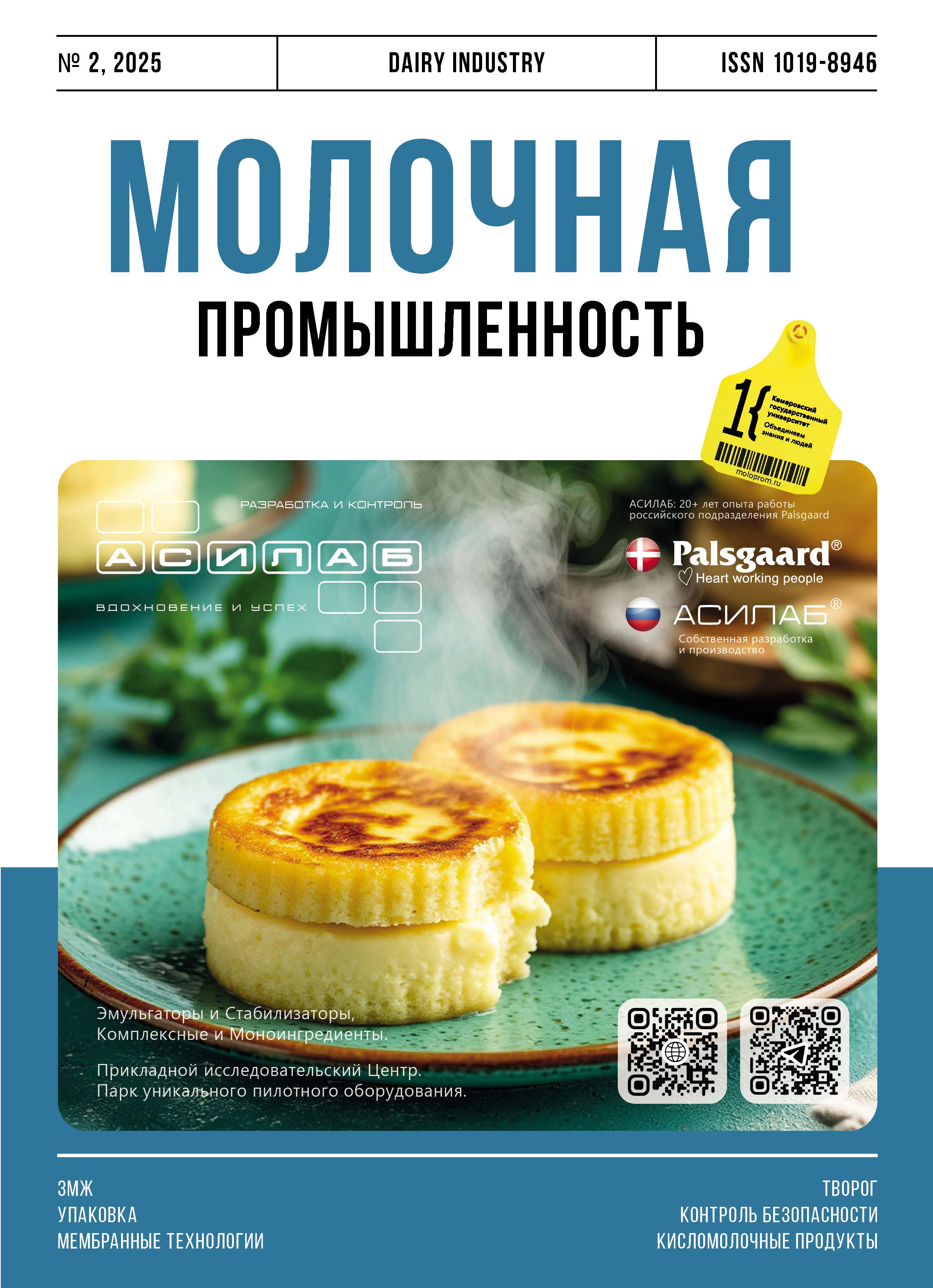Uglich, Russian Federation
Uglich, Russian Federation
Chlorine dioxide is a popular industrial disinfectant that possesses antimicrobial properties against various viruses and microorganisms, including gram-positive, gram-negative, and spore-forming bacteria. However, the available data become contradictory when it comes to the effect of pH on the bactericidal efficiency of chlorine dioxide against staphylococci and spore-forming microorganisms. The article describes the effect of pH 3–11 on the bactericidal efficiency of chlorine dioxide against gram-positive Staphylococcus aureus and spore-forming Bacillus subtilis. The initial contamination was 105 CFU/cm3. The effect of pH on the bactericidal properties of chlorine dioxide depended on the microorganism. The research revealed the complex effect of pH of the medium and the concentration of chlorine dioxide on the bactericidal efficiency against the gram-positive staphylococci and the sporeforming bacteria. For Staphylococcus aureus, a lower concentration of chlorine dioxide limited the effective range of active acidity with a shift to the acidic pH zone. The lowest concentration of chlorine dioxide enough to inhibit the growth of staphylococcus cells was 0.1 % at pH 3–5 while 0.5% proved effective throughout the entire pH range of 3–11. For Bacillus subtilis, the disinfecting effect did not depend on the pH of the medium when it remained within pH 3–9 and partially lost its efficiency at pH 10–11. At pH 3–9, the effective dosage of chlorine dioxide was ≥0.2% for Staphylococcus aureus and ≥0.5% for Bacillus subtilis.
chlorine dioxide, bactericidal efficiency, disinfection efficiency, test culture, Staphylococcus aureus , Bacillus subtilis, active acidity, disinfectant concentration
1. Yee, S. Efficacy of chlorine dioxide as a disinfectant / Yee S. [et al.] // Progress In Microbes & Molecular Biology. 2020. Vol 3(1). https://doi.org/10.36877/pmmb.a0000128
2. Jonnalagadda, S. B. Chlorine dioxide for bleaching, industrial applications and water treatment / S. B. Jonnalagadda, S. Nadupalli // Indian Chemical Engineer. 2014. Vol. 56(2). R. 123–136. https://doi.org/10.1080/00194506.2014.881032
3. Jiang, Y. Application of chlorine dioxide and its disinfection mechanism / Y. Jiang [et al.] // Archives of Microbiology. 2024. Vol. 206(10). 400. https://doi.org/10.1007/s00203-024-04137-7
4. Andrés, C. M. C. Chlorine dioxide: friend or foe for cell biomolecules? A chemical approach / C. M. C. Andrés [et al.] // International Journal of Molecular Sciences. 2022. Vol. 23 (24). 15660. https://doi.org/10.3390/ijms232415660
5. Petrosyan, O. P. Analiticheskiy obzor reagentov, ispol'zuemyh v vodopodgotovke / O. P. Petrosyan [i dr.] // Elektronnyy zhurnal: nauka, tehnika i obrazovanie. 2016. №. 1(5). S. 195–215. https://elibrary.ru/wnifgz
6. Jefri, U. H. N. M. A systematic review on chlorine dioxide as a disinfectant / U. H. N. M. Jefri [et al.] // Journal of Medicine and Life. 2022. Vol. 15(3). 313. https://doi.org/10.25122/jml-2021-0180
7. Han, J. Low chlorine impurity might be beneficial in chlorine dioxide disinfection / J. Han, X. Zhang, W. Li, J. Jiang // Water research. 2021. Vol. 188. 116520. https://doi.org/10.1016/j.watres.2020.116520
8. Al-Otoum, F. Disinfection by-products of chlorine dioxide (chlorite, chlorate, and trihalomethanes): Occurrence in drinking water in Qatar / F. Al-Otoum [et al.] // Chemosphere. 2016. Vol. 164. R. 649–656. https://doi.org/10.1016/j.chemosphere.2016.09.008
9. Kim, H. Production and stability of chlorine dioxide in organic acid solutions as affected by pH, type of acid, and concentration of sodium chlorite, and its effectiveness in inactivating Bacillus cereus spores / H. Kim [et al.] // Food microbiology. 2008. Vol. 25(8). R. 964–969. https://doi.org/10.1016/j.fm.2008.05.008
10. Wu, M. S. Inactivation of antibiotic-resistant bacteria by chlorine dioxide in soil and shifts in community composition / M. S. Wu, X. Xu // RSC advances. 2019. Vol. 9(12). R. 6526–6532. https://doi.org/10.1039/c8ra07997h
11. Ofori, I. Chlorine dioxide inactivation of Pseudomonas aeruginosa and Staphylococcus aureus in water: The kinetics and mechanism / I. Ofori [et al.] // Journal of water process engineering. 2018. Vol. 26. R. 46–54. https://doi.org/10.1016/j.jwpe.2018.09.001
12. Ofori, I. Chlorine dioxide oxidation of Escherichia coli in water – A study of the disinfection kinetics and mechanism / I. Ofori [et al.] // Journal of Environmental Science and Health, Part A. 2017. Vol. 52(7). R. 598–606. https://doi.org/10.1080/10934529.2017.1293993
13. Sviridenko, G. M. Vliyanie rn na baktericidnuyu effektivnost' dioksida hlora otnositel'no test-kul'tury Escherichia coli / G. M. Sviridenko, T. V. Komarova, M. B. Zaharova // Molochnaya promyshlennost'. 2024. № 6. S. 76–81. https://doi.org/10.21603/1019-8946-2024-6-18; https://elibrary.ru/fljauv
14. Sviridenko, G. M. Mikrobiologicheskie riski pri proizvodstve moloka i molochnyh produktov / G. M. Sviridenko. – M.: Izdatel'stvo Rossel'hozakademii, 2009. – 246 s.
15. Malyshev, D. Mode of Action of Disinfection Chemicals on the Bacterial Spore Structure and Their Raman Spectra / D. Malyshev [et al.] // Analytical Chemistry. 2021. Vol. 93(6). R. 3146–3153. https://doi.org/10.1021/acs.analchem.0c04519
16. Young, S. B. Mechanisms of killing of Bacillus subtilis spores by hypochlorite and chlorine dioxide / S. B. Young, P. Setlow // Journal of Applied Microbiology. 2003. Vol. 9(1). R. 54–67. https://doi.org/10.1046/j.1365-2672.2003.01960.x
17. Marcon, J. New insights into the decomposition mechanism of chlorine dioxide at alkaline pH / J. Marcon [et al.] // Holzforschung. 2017. Vol. 71(7-8). R. 599–610. https://doihttps://doi.org/10.1515/hf-2016-0147
18. Odeh, I. N. New pathways for chlorine dioxide decomposition in basic solution / I. N. Odeh, J. S. Francisco, D. W. Margerum // Inorganic chemistry. 2002. Vol. 41(24). R. 6500–6506. https://doi.org/10.1021/ic0204676





